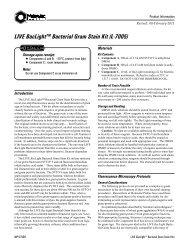Vertical Vegetation Structure Below Ground: Scaling from Root
Vertical Vegetation Structure Below Ground: Scaling from Root
Vertical Vegetation Structure Below Ground: Scaling from Root
Create successful ePaper yourself
Turn your PDF publications into a flip-book with our unique Google optimized e-Paper software.
<strong>Vertical</strong> <strong>Vegetation</strong> <strong>Structure</strong> <strong>Below</strong> <strong>Ground</strong>: <strong>Scaling</strong> <strong>from</strong> <strong>Root</strong> to Globe 361sional root growth in response to heterogeneous distributions of phosphorusin the soil and also analyzed the effects of different branching patternson competition among roots of the same plant. Ho et al. (2004) addedresponses to heterogeneous distributions of soil water to this model. <strong>Root</strong>distributions resulting <strong>from</strong> hydrotropic growth were simulated successfullyin two dimensions by a model developed by Tsutsumi et al. (2003a,b).In two other recent modeling studies (Grant 1998; Biondini 2001),simulationsof three-dimensional root growth were incorporated into highlycomplex plant growth models that simulate numerous aspects of plantgrowth,development, and resource allocation in response to environmentalconditions. <strong>Root</strong> growth in these models responds to heterogeneousdistributions of nutrients and soil water.6.1.1 Continuum Models of <strong>Root</strong> GrowthRecent two-dimensional continuum models that incorporate responses ofroot densities to soil conditions include the model of Chen and Lieth (1993),in which root densities respond to soil water potential and temperature,and the model of Heinen et al. (2003),in which roots respond to nutrientcontents. In the one-dimensional models of Adiku et al. (1996) and vanWijk and Bouten (2001),root densities respond to soil water content. Bothof these models simulate vertical root distributions using optimizationmethods. Such methods are discussed below. Continuum models holdpromise for application at the community level,where explicit simulationsof the root system architectures of multiple plants would be impractical.6.1.2 Optimization Approaches to Predict <strong>Vertical</strong> <strong>Root</strong> DistributionsOptimization schemes that distribute vertical root distributions in waysthat minimize plant energy expenditure and/or maximize water and nutrientuptake have been used in several models,at scales ranging <strong>from</strong> the levelof individual root systems (Ge et al. 2000; Ho et al. 2004) to the globe(Kleidon and Heimann 1998). The continuum model by Adiku et al. (1996)used an optimization scheme to partition roots within the soil profile inorder to maximize water uptake while minimizing plant energy use. Arelated approach was used in a model developed by van Wijk and Bouten(2001),in which roots were distributed vertically so as to maximize wateruptake in the presence or absence of root competition. In a model bySchwinning and Ehleringer (2001) a carbon-gain optimization scheme wasused to partition roots of different functional types of desert plants between
















